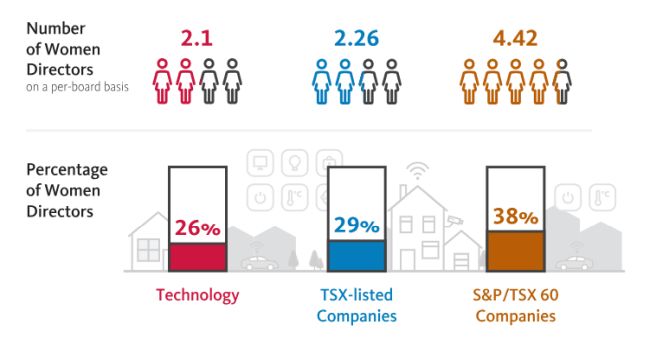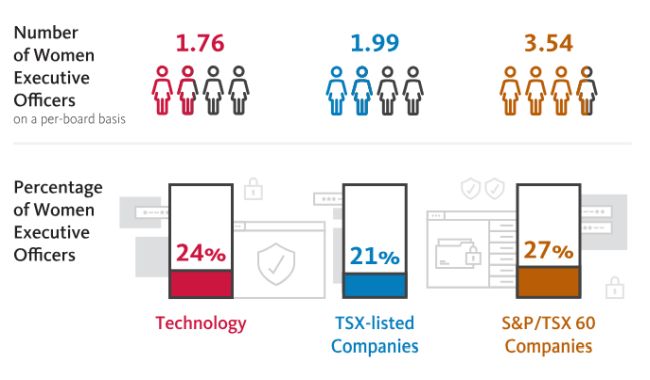- with Senior Company Executives, HR and Finance and Tax Executives
- with readers working within the Accounting & Consultancy, Banking & Credit and Healthcare industries
Canada's technology industry has consistently ranked near the bottom of TSX-listed companies in terms of the number and percentage of women on their boards, and in the middle of the pack for women in senior leadership. The past year saw some gains in both metrics, but many longstanding challenges remain.
A crucial factor behind these figures is one common to several underperforming sectors: a lack of women at all career stages. For over a decade, women have made up less than 30% of Canada's tech workforce, where it seems to have stalled. In technical roles, like software developers and engineers, the figure is even lower. And when so few women have the opportunity to gain the skills and experience required to move into progressively more senior positions, it's little wonder that their representation is sparse at those levels.
Parallel to that are a lack of mentorship opportunities for women earlier in their careers and gaps in how companies attract, support and retain entry- and mid-level talent. Biased hiring processes, hostile work cultures, lack of genuine commitment to gender equality from senior management and decades-old systemic barriers combine to keep many women out of tech roles and to push many qualified women back out: some estimate the turnover rate for women in tech to be double that of their male counterparts.
Such low representation is typical among international tech markets, too. In the United States, women comprise about 30% of positions in the tech sector but twice that figure do in the wider economy. The issue is so pronounced and engrained that Silicon Valley startups have referred to the "Dave rule" — an industry inside joke whereby an acceptable gender balance is achieved through a 1:1 ratio of male employees named Dave and women — since the turn of the century.
Despite growing awareness of these disparities, with more tech companies adopting DEI targets and setting out strategies to achieve them, the sector clearly still has a long way to go.
Latest diversity data
Osler's 2023 Diversity Disclosure Practices: Diversity and leadership at Canadian public companies report shows that 26% of directors at technology companies in 2023 were women (up from 23% in 2022), compared to 28.5% for TSX-listed companies as a whole. On a per-board basis, the number of women directors was 2.1 (up from 1.8 last year), versus 4.42 women directors per board for S&P/TSX 60 companies and 2.26 for TSX-listed companies overall.
Breakdown of number and percentages of women directors in 2023

Women hold 24% of executive officer positions at Canadian technology companies, a significant increase from 20% last year and higher than the 20.8% average for TSX-listed companies. On a per-company basis, though, it's just 1.76, compared to 1.99 for the average TSX company and 3.54 for S&P/TSX 60 companies.
Breakdown of number and percentages of women executive officers in 2023

Trends since 2015
Osler's survey results since 2015 point to a marked increase in women's representation in tech leadership over the years, from 10% in 2015 to 26% in 2023. Still, relative to the average TSX-listed company, which moved from 10 to 29% over the same time period, women continue to be underrepresented on technology company boards.
Better progress has occurred in the C-suite. Our results indicate that the percentage of women holding executive officer positions at technology companies has increased from 9.7% in 2015 to 24% in 2023. Over the same time period, the average TSX-listed company moved from 13.5% to 20.8%.
Best practices and sector leaders
Osler's research has identified a number of Canadian technology companies leading the way in these efforts. These include
- Converge Technologies Solutions Corp. — established mentorship programs for women executives and employees to share professional advice; opportunities and dedicated time to invest in leadership development
- ATS Automation Tooling Systems Inc. — strong focus on engaging, developing and mentoring women for future leadership; external community outreach for recruitment and advancement of qualified women candidates; collaborations with educational institutions and regional conferences to inspire and connect with young women interested in STEM fields
- Xtract One Technologies — conducting regular reviews of pay equity and defining a roadmap to address identified gaps
In the years to come, technology companies should focus on creating more inclusive cultures, supporting mentorship opportunities, identifying and removing biases from hiring and promotion processes to reverse many of the sector's long-embedded gender inequities.
The content of this article is intended to provide a general guide to the subject matter. Specialist advice should be sought about your specific circumstances.


